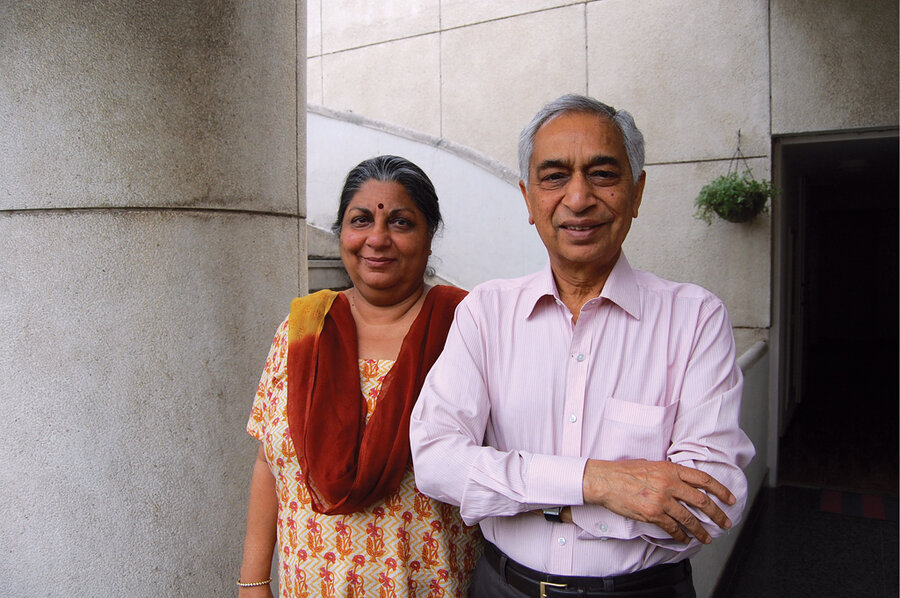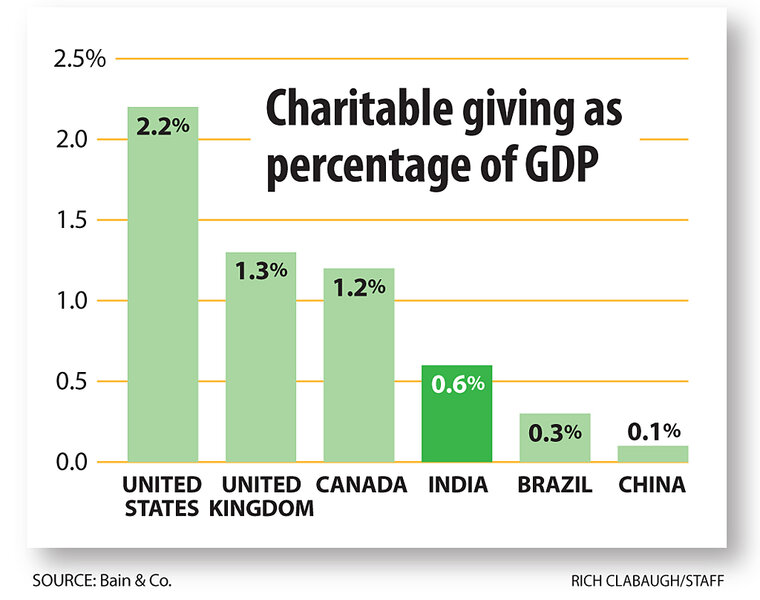New donors emerge in developing countries
Loading...
| Mumbai
The Nayyars could have retired comfortably after Reva's more than 30 years in the Indian Civil Service. Her husband, Vineet, was on his third career – at India's fourth-largest information-technology firm – after stints in government and at the World Bank. Their youngest child had just graduated from Harvard Business School.
Instead, the Nayyars used some of their new wealth to take on a new project: donating more than 300 million rupees (about $6.6 million) in March to a foundation named for Mr. Nayyar's father, which funds a dozen education projects and thousands of children around New Delhi.
"India is at the early stages [of philanthropy]. I think everyone is fulfilling their dreams of being rich at the moment," Mrs. Nayyar says, after visiting a Mumbai (Bombay) area school where she's a trustee. "But one day soon I think they will realize that you don't carry this to the grave. Life is finite."
As major developing economies leap forward, they're creating a fast-growing class of wealthy residents who may reach the same conclusion as the Nayyars. If so, they will change the face of international giving from a largely Western affair to a much larger, more diverse group of donors. The new philanthropists may also change the targets of the aid, choosing to address pressing issues near their own homes.
"I think what you're seeing is the journey of a philanthropist being vastly accelerated," says Jane Wales, founder of the Global Philanthropy Forum in San Francisco. Reforms in India, China, and other nations have rapidly created wealth, "but at the same time new disparities, and so there was a new consciousness ... that economic good fortune [could be] more evenly shared," she adds.
In many ways, India leads the way in emerging-nation philanthropy. Its pool of millionaires (technically, those with investable assets over $1 million) has grown an average 11 percent a year since 2000, one of the fastest such rates in the world, says a recent report from Bain & Co., a global consulting firm. Despite the global recession, the number of billionaires here grew from 27 in 2009 to 52 this year, Forbes reported in March. One result: India's charitable giving rose to 0.6 percent of gross domestic product by 2006, topping Brazil's 0.3 percent and China's 0.1 percent, according to Bain (see chart).
The flip side is that India's philanthropy greatly lags that of the United States (2.2 percent) and the United Kingdom (1.3 percent). Part of the difference is the legal incentives offered to donors in the US. A hefty inheritance tax – up to 46 percent on estates over $2 million – encourages individuals to set up foundations and donate money. No such law exists in many other countries, including India and China. Another reason is time.
"I think you would find that in the US or European markets philanthropy didn't really flourish, root itself, until many years, decades, after wealth was created," says Arpan Sheth, a partner at Bain who wrote the report. "There's a psychology of scarcity. Therefore for India, the tipping point for philanthropy has yet to come. But you can begin to see it now."
A sense of confidence in continued economic growth is being rooted in the newly wealthy, says Deval Sanghavi, a former New York investment banker and now managing partner of the Mumbai-based Dasra, which consults with prospective donors on strategic giving here. "There's this belief, understanding ... of security now that these [wealthy] individuals have that it's not a bubble, it's not going to end. And I think you could probably compare this to the US 100 years ago."
In March, Dasra held the first Indian Philanthropy Forum, modeled after Ms. Wales's program, to introduce prospective Indian donors to leaders of nongovernmental organizations. In 2008, roughly half of United Way's non-US giving came from developing countries, nearly $700 million of the total $5.26 billion budget, says Atul Tandon, executive director of the international network of United Way Worldwide, the world's largest charity operator by revenue. Mr. Tandon says that the "dramatic growth" in giving over the past decade has come from the developing world and will continue.
Jobs, not philanthropy, will lift India's nearly half billion poor out of poverty, Bain's Mr. Sheth adds.
They need not only jobs but education, says Mrs. Nayyar. While India is not well endowed with natural resources, "we have people. They are our resource."
RELATED:
Charities want you to text in your donation. Does it work?







